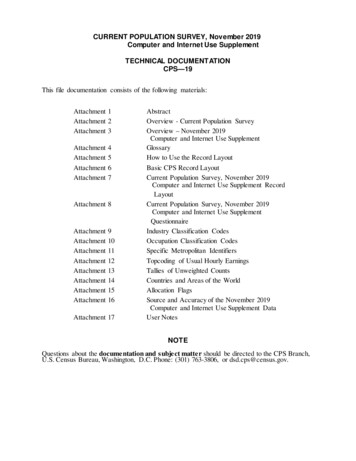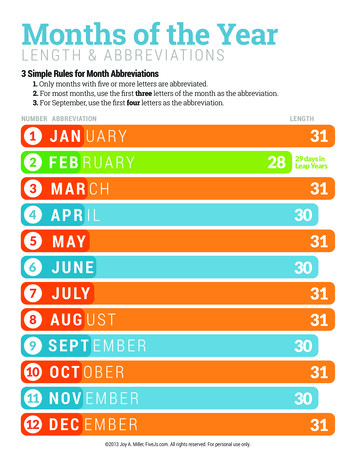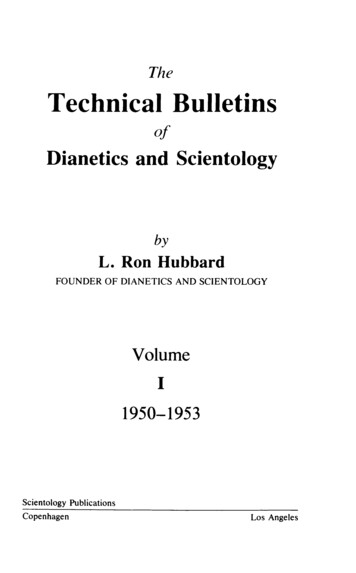
Transcription
CURRENT POPULATION SURVEY, November 2019Computer and Internet Use SupplementTECHNICAL DOCUMENTATIONCPS—19This file documentation consists of the following materials:Attachment 1Attachment 2Attachment hment chment 17AbstractOverview - Current Population SurveyOverview – November 2019Computer and Internet Use SupplementGlossaryHow to Use the Record LayoutBasic CPS Record LayoutCurrent Population Survey, November 2019Computer and Internet Use Supplement RecordLayoutCurrent Population Survey, November 2019Computer and Internet Use SupplementQuestionnaireIndustry Classification CodesOccupation Classification CodesSpecific Metropolitan IdentifiersTopcoding of Usual Hourly EarningsTallies of Unweighted CountsCountries and Areas of the WorldAllocation FlagsSource and Accuracy of the November 2019Computer and Internet Use Supplement DataUser NotesNOTEQuestions about the documentation and subject matter should be directed to the CPS Branch,U.S. Census Bureau, Washington, D.C. Phone: (301) 763-3806, or dsd.cps@census.gov.
ATTACHMENT 1ABSTRACTCurrent Population Survey, November 2019: Computer and Internet Use Supplementmicrodata file] / conducted by the Census Bureau for theU.S. Department of Commerce, National Telecommunications and Information Administration.Washington: U.S. Census Bureau [producer and distributor], 2020.Type of FileMicrodata; unit of observation is individuals within housing units.Universe DescriptionThe universe consists of all persons in the civilian noninstitutional population of the United States livingin households. The probability sample selected to represent the universe consists of approximately 50,000households.Subject-Matter DescriptionData are provided on labor force activity for the week prior to the survey. Comprehensive data areavailable on the employment status, occupation, and industry of persons 16 years old and over. Alsoshown are personal characteristics such as age, sex, race, marital status, veteran status, householdrelationship, educational background, and Hispanic origin.The Computer and Internet Use Supplement collected household information from all eligible CPShouseholds, as well as person information from household members 3 years old and over. Data areprovided about the household’s computer and internet use and about each household member's use of theinternet from any location in the past year. It also asked about a random respondent’s use of the Internet.Geographic CoverageStates, regions and divisions are identified in their entirety. Within confidentiality restrictions; indicatorsare provided for 278 selected core-based statistical areas (CBSA), 30 selected combined statistical areas(CSA), 217 counties, and 76 central cities in multi-central city core-based statistical areas or combinedstatistical areas. Also within confidentiality restrictions, indicators are provided for metropolitan/nonmetropolitan, central city/balance metropolitan, and CBSA size.Technical DescriptionFile Structure: Rectangular.File Size: 138,850 logical records; 1,236 character logical record length.File Sort Sequence: State rank by CBSA rank by household identification number by line number.Reference Materials:Current Population Survey, November 2019: Computer and Internet Use Supplement TechnicalDocumentation. Documentation contains this abstract, questionnaire facsimiles, and record layouts of thefile.1-1
U.S. Census Bureau. The Current Population Survey Design and Methodology (Technical Paper 77)describes in detail the sample design and survey procedures used as well as the accuracy of estimates andsampling errors. Copy is available at caldocumentation/complete.html.For information about the Current Population Survey and other Census Bureau data products, be sure tovisit our online Question & Answer Center on the Census Bureau’s home page (http://www.census.gov/)where you can search our knowledge base and submit questions.File Availability:Microdata and technical documentation are available through the Current Population Surveywebsite at -2
ATTACHMENT 2OVERVIEWCurrent Population SurveyIntroductionThe Current Population Survey (CPS) is the source of the official government statistics on employment andunemployment. The CPS has been conducted monthly for over 50 years. Currently, we obtain interviews fromabout 54,000 households monthly, scientifically selected on the basis of area of residence to represent the nation asa whole, individual states, and other specified areas. Each household is interviewed once a month for fourconsecutive months one year, and again for the corresponding time period a year later. This technique enables us toobtain reliable month-to-month and year-to-year comparisons at a reasonable cost while minimizing theinconvenience to any one household.Although the main purpose of the survey is to collect information on the employment situation, a very importantsecondary purpose is to collect information on demographic characteristics such as age, sex, race, marital status,educational attainment, family relationship, occupation, and industry. From time to time, additional questions areincluded on health, education, income, and previous work experience. The statistics resulting from these questionsserve to update similar information collected once every 10 years through the decennial census, and are used bygovernment policymakers and legislators as important indicators of our nation's economic situation and forplanningand evaluating many government programs.The CPS provides current estimates of the economic status and activities of the population of the United States.Because it is not possible to develop one or two overall figures (such as the number of unemployed) that wouldadequately describe the whole complex of labor market phenomena, the CPS is designed to provide a large amountof detailed and supplementary data. Such data are made available to meet a wide variety of needs on the part ofusers of labor market information.Thus, the CPS is the only source of monthly estimates of total employment (both farm and nonfarm); nonfarm selfemployed persons, domestics, and unpaid helpers in nonfarm family enterprises; wage and salaried employees; and,finally, estimates of total unemployment.It provides the only available distribution of workers by the number of hours worked (as distinguished fromaggregate or average hours for an industry), permitting separate analyses of part-time workers, workers on overtime,etc. The survey is also the only comprehensive current source of information on the occupation ofworkers and the industries in which they work. Information is available from the survey not only for personscurrently in the labor force but also for those who are outside the labor force. The characteristics of such persons whether married women with or without young children, disabled persons, students, older retired workers, etc., canbe determined. Information on their current desire for work, their past work experience, and their intentions as tojob seeking are also available.For a more detailed discussion about the basic labor force data gathered on a monthly basis in the CPS survey, see"Explanatory Notes and Estimates of Error" in any recent issue of the Employment and Earnings, a Bureau of LaborStatistics periodical. This source is referred to on the next page.2-1
CPS Sample DesignThe Current Population Survey (CPS) is a monthly survey designed primarily to produce national and state estimatesof labor force characteristics of the civilian noninstitutional population (CNP) 16 years of age and older. It isconducted in approximately 60,000 eligible housing units throughout the United States. (Note: ‘Eligible’ can besimplistically defined as an occupied housing unit having at least one person in the CNP.) This sample includes10,000 eligible housing units from the monthly supplementary sample to improve state-level estimates of healthinsurance coverage for low-income children, also known as the CHIP expansion. This supplementary sample hasbeen part of the official CPS since July 2001. Thirty-two states plus the District of Columbia contain thissupplementary sample each month.The CPS sample is based on information from the 2010 Decennial Census, in accordance with usual practice.Historically, the CPS sample has been redesigned after each Decennial Census.The CPS sample is a probability sample based on a stratified two-stage sampling scheme: selection of sampleprimary sampling units (PSUs) and selection of sample housing units within those PSUs. In general, the CPS sampleis selected from lists of addresses obtained from the Master Address File (MAF) with updates from the United StatesPostal Service (USPS) twice a year. The MAF is the Census Bureau’s permanent list of addresses, including theirgeographic locations, for individual living quarters. It is continuously maintained through partnerships with theUSPS; with Federal, State, regional, and local agencies; and with the private sector, and it is used as a sample frameby many Census Bureau demographic surveys.Approximately 72,000 housing units are assigned for interview each month, of which about 60,000 are occupiedand thus eligible for interview. The remainder are units found to be destroyed, vacant, converted to nonresidentialuse, containing persons whose usual place of residence is elsewhere, or ineligible for other reasons. Of the 60,000occupied housing units, approximately 10 percent are not interviewed in a given month due to temporary absence(vacation, etc.), the residents are not found at home after repeated attempts, inability of persons contacted torespond, unavailability for other reasons, and refusals to cooperate. The interviewed households containapproximately 108,000 persons 15 years old and over, approximately 27,000 children 0-14 years old, and about450 Armed Forces members living with civilians either on or off base within these households. A more preciseexplanation regarding the CPS sample design is provided in "Explanatory Notes and Estimates of Error:Household Data - Sampling" in any issue of Employment and Earnings.Relationship of Current Population Survey Files to PublicationsEach month, a significant amount of information about the labor force is published by the Bureau of LaborStatistics in the Employment and Earnings and Monthly Labor Review reports.As mentioned previously, the CPS also serves as a vehicle for supplemental inquiries on subjects other thanemployment, which are periodically added to the questionnaire. From the basic and supplemental data, the Bureauof the Census issues three series of publications under the general title Current Population Reports:P-20 Population CharacteristicsP-23 Special StudiesP-60 Consumer IncomeAll Current Population Reports, including the other series for population estimates and projections and specialcensuses, may be obtained by subscription fromthe U.S. Government Printing Office at 202-783-3238.Subscriptions are available as follows: Population Characteristics, Special Studies, and Consumer Income series(P-20, P-23, P-60) combined, 101 per year (sold as a package only); Population Estimates and Projections, (P-25),2-2
27 per year. Single issues may be ordered separately; ordering information and prices are provided in the Bureauof the Census Catalog and Guide, the Monthly Product Announcement (MPA), and in Census and You. Selectedreports also may be accessed on the INTERNET at phic LimitationsThe CPS sample was selected so that specific reliability criteria were met nationally, for each of the 50 States and forthe District of Columbia. Since 1985, these reliability criteria have been maintained through periodic additionsand deletions in the State samples. Estimates formed for geographic areas identified on the microdata file which aresmaller than states are not as reliable.2-3
WeightsUnder the estimating methods used in the CPS, all of the results for a given month become available simultaneouslyand are based on returns for the entire panel of respondents. The CPS estimation procedure involves weighting thedata from each sample person. The base weight, which is the inverse of the probability of the person being in thesample, is a rough measure of the number of actual persons that the sample person represents. Almost all samplepersons in the same state have the same base weight, but the weights across states are different. Selectionprobabilities may also differ for some sample areas due to field subsampling, which is done when areas selected forthe sample contain many more households than expected. The base weights are then adjusted for noninterview, andthe ratio estimation procedure is applied.1.Noninterviewadjustment. The weights for all interviewed households are adjusted to the extent neededto account for occupied sample households for which no information was obtained because of absence,impassable roads, refusals, or unavailability of the respondent for other reasons. This noninterviewadjustment is made separately for clusters of similar sample areas that are usually, but not necessarily,contained within a state. Similarity of sample areas is based on Core-Based Statistical Area (CBSA) statusand size. Within each cluster, there is a further breakdown by residence. Each CBSA cluster is split by"principal city" and "balance of the CBSA." The proportion of occupied sample households notinterviewed fluctuates around 8 percent depending on weather, vacations, etc.2.Ratio estimates. The distribution of the population selected for the sample may differ somewhat, bychance, from that of the population as a whole in such characteristics as age, race, sex, and state ofresidence. Because these characteristics are closely correlated with labor force participation and otherprincipal measurements made from the sample, the survey estimates can be substantially improved whenweighted appropriately by the known distribution of these population characteristics. This is accomplishedthrough two stages of ratio adjustment as follows:a. First-stage ratio estimate. The purpose of the first-stage ratio adjustment is to reduce the contributionto variance that results from selecting a sample of PSUs rather than drawing sample households fromevery PSU in the nation. This adjustment is made to the CPS weights in two race cells: black andnonblack; it is applied only to PSUs that are nonself-representing and for those states that have asubstantial number of black households. The procedure corrects for differences that existed in eachstate cell at the time of the 2000 census between 1) the race distribution of the population in samplePSUs and 2) the race distribution of all PSUs (both 1 and 2 exclude self-representing PSUs).b. Second-stage ratio estimate. This procedure substantially reduces the variability of estimates andcorrects, to some extent, for CPS undercoverage. The CPS sample weights are adjusted to ensure thatsample-based estimates of population match independent population controls. Three sets of controlsare used:1)51 state controls of the civilian noninstitutional population 16 years of age and older2)national civilian noninstitutional population controls for 14 hispanic and 5 nonhispanic age-sexcategories3)national civilian noninstitutional population controls for 66 white, 42 black, and 10 "other" agesex categories2-4
The independent population controls are prepared by projecting forward the resident population asenumerated on April 1, 2000. The projections are derived by updating demographic census datawith information from a variety of other data sources that account for births, deaths, and netmigration. Estimated numbers of resident Armed Forces personnel and institutionalized personsreduce the resident population to the civilian noninstitutional population. Estimates of net censusundercount, determined from the Post Enumeration Survey, are added to the populationprojections. Prior to January 2003, the projections were based on earlier censuses, and prior toJanuary 1994, there was no correction for census undercount. A summary of the currentprocedures used to make population projections is given in “Revisions in the Current PopulationSurvey Effective January 2003" in the January 2003 issue of Employment and Earnings.Comparability of CPS From Microdata Files With Published SourcesAlthough total estimates of the total population will equal published estimates, labor force estimates produced froma microdata file may not be directly comparable or identical with the published nonseasonally adjusted labor forcedata. The official labor force statistics published by the Bureau of Labor Statistics (BLS) are calculated using theCPS composite weight (PWCMPWGT). Anyone wanting to replicate not seasonally adjusted BLS estimates shoulduse this weight. However, not all estimates made from a public use file will match such weighted publishedestimates. This is because of various steps taken in the creation of CPS public use files to protect the confidentialityof CPS respondents. Top side estimates for most major demographic and economic categories such as age, race,gender and major labor force status will agree with the published totals; however, estimates for smallgroups/combinations of these characteristics will differ. The same is true for any estimates for any demographic orlabor force characteristic not listed above. Such estimates will be similar but not identical.Another factor also inhibits microdata comparison with published labor force data. This is the seasonal adjustmentthat is applied to many published statistics. This adjustment is used to adjust for normal seasonal variations to helpdistinguish the underlying economic situation in month-to-month changes and is not reflected in any of the weightsor variables included on the public use files.Shown below are data from January and July 2015 which demonstrate how estimates compiled using the finalweights from the microdata file may differ from the published composited estimates, with and without seasonaladjustment. Note that the composite estimation procedure was not used for estimates published from January 1994to May 1994. For a further description of both the composite estimator and seasonal adjustment, see the most recentof the CPS Technical Paper (66 or 77).2-5
Comparison of CPS Estimates from Microdata Files with Published SourcesCivilianCivilianNot --January 2015Data (000's)Final Not uly 1993Data (000's)Final Not 2-6
ATTACHMENT 3OVERVIEWNovember 2019: Computer and Internet Use SupplementGeneralThe November 2019 Computer and Internet Use Supplement was conducted as a supplement to thatmonth's Current Population Survey (CPS). The CPS is a monthly labor force survey conducted inapproximately 52,000 interviewed households across the country. Attachment 8 is a facsimile ofthe document used by the CPS with the November 2019 Computer and Internet Use Supplementquestions. See "Overview-Current Population Survey" (Attachment 2) for a description of theCPS; the following describes the November 2019 Computer and Internet Use Supplement questionsasked of persons 3 years old and over.Data CollectionThe November 2019 Computer and Internet Use Supplement collected household information fromall eligible CPS households, as well as person information from household members 3 years oldand over. Proxy responses were allowed. The supplement contained questions about thehousehold’s computer and internet use and about the household member's use of the internet fromany location in the past year. It also asked about a random respondent’s use of the Internet.Interviews were conducted during the period of November 10 - 19, 2019. Interviewers wereprovided with a two-hour home study for completing the basic CPS labor force exercises,supplement exercises, and a practice interview concerning the supplement.Data ProcessingThe data processing involved a consistency edit and allocation module for all computer and internet usesupplement items. The consistency edit mainly ensured that the entries within an individual recordfollowed the correct skip pattern. Items with missing values were assigned values, if appropriate. Whena response is not obtained for a particular data item, or an inconsistency in reported items is detected, an"imputed" response is entered in the field. Imputation is performed using a "hot deck" method, wherebya response from another sample person with similar demographic and economic characteristics is usedfor the nonresponse. The imputation procedure is performed one item at a time.The values and universes for each variable are defined in the supplement record layout(Attachment 7).November 2019 Computer and Internet Use Supplement Computer FileThe November 2019 Computer and Internet Use File consists of two parts: the CPS labor forcedata and the supplement data.3-1
A. The CPS Labor Force DataThe November 2019 CPS file contains 138,850 records. The first 1,000 characters containthe labor force data for each record. Attachment 6 contains the CPS Basic Items RecordLayout, which includes the variable name, character size, location on the record, universe,and the possible values of each basic CPS variable included on the file.The variable PRPERTYP (located in positions 161-162 on the CPS Basic ItemsRecord Layout) determines the type of person as follows:PRPERTYP1 Child household member (0-14 years old)2 Adult civilian household member (15 years old)3 Adult Armed Forces household member (15 years old)The variable HRINTSTA (located in positions 57-58 on the CPS Basic ItemsRecord Layout) determines the interview status of the household.HRINTSTA1 Interview2 Type A Noninterview (These records represent households that were eligiblefor the August CPS interview but were not interviewed because no one washome, household members were temporarily absent, etc.)3 Type B Noninterview (These records represent sample addresses determinedto be ineligible for the CPS by virtue of being vacant, demolished,nonresidential, etc.)4 Type C Noninterview (See explanation for Type B above)By combining the values of PRPERTYP (1-3) and HRINTSTA (2-4), the number ofrecords can be determined.The values of PRPERTYP are:Unweighted Counts1 Child2 Adult Civilian, 15 3 Adult, Armed Forces20,74796,9274233-2
The values of HRINTSTA are:1 Interview2 Type A Noninterview3 Type B Noninterview4 Type C Noninterview49,52810,17910,020554B. November 2019 Computer and Internet Use Supplement DataThe November supplement data are in locations 1001-1236. (See Attachment 7)C. Tallying the November 2019 Supplement FileThe November 2019 supplement universe consists of the CPS sample for all households and forcivilian persons age 3 and over.D. WeightingThe November 2019 Computer and Internet Use supplement is a fully allocated supplement.The basic CPS person (PWSSWGT) and household (HWHHWGT) weights may be used totally the supplement.There is, however, a weight associated with the random respondent questions. This weight,PWPRMWGT, should be used with the random respondent questions which include PEEMAILthrough PEHOMIOT. This weight must be used when tallying these supplement questions.Attachment 13 is a tally listing of unweighted counts from selected supplement items. Usethese totals to ensure that the file is being accessed properly.E. Data ContactFor questions regarding the November 2019 supplement data, call the CPS Branch on(301) 763-3806.3-3
ATTACHMENT 4GLOSSARYCurrent Population SurveyAge Age classification is based on the age of the person at his/her last birthday. The adult universe (i.e.,population of marriageable age) is comprised of persons 15 years and over for CPS labor force data.Allocation Flag Each edited item has a corresponding allocation flag indicating the nature of the edit. See theattachment on allocation flags for more information. The second character of the item name is always "X".Armed Forces Demographic information for Armed Forces members (enumerated in off-base housing or on-basewith their families) is included on the CPS data files. No labor force information is collected of Armed Forcesmembers in any month. In March, supplemental data on income are included for Armed Forces members. This isthe only month that non-demographic information is included for Armed Forces members.Civilian Labor Force (See Labor Force.)Class of Worker This refers to the broad classification of the person's employer. These broad classifications forcurrent jobs are:1)2)3)4)5)6)Federal governmentState governmentLocal governmentPrivate industry (including self-employed, incorporated)Self-employed (not incorporated)Working without payDomain The domain for an item is a list or range of its possible values. Note that all unedited items have possiblevalues of -1 (blank), -2 (don't know), and -3 (refused). Since all items have these possible values, they are notshown as valid entries for each item.Duration of Unemployment Duration of unemployment represents the length of time (through the current surveyweek) during which persons classified as unemployed are continuously looking for work. For persons on layoff,duration of unemployment represents the number of full weeks since the termination of their most recentemployment. A period of two weeks or more during which a person is employed or ceased looking for work isconsidered to break the continuity of the present period of seeking work.Earners, Number of The file includes all persons 15 years old and over in the household with 1 or more in wagesand salaries, or 1 or more of a loss in net income from farm or nonfarm self-employment during the precedingyear.Edited item An edited item is allocated or imputed by the processing system. In most cases this means allocatinga value where the unedited item contains a value of blank, "don't know", or "refused". The second character of theitem name is always "E".An edited version of an item exists only if that item is processed through the edits. If the edits never deal with aparticular item, then that item only has an unedited version.4-1
Since the instrument enforces skip patterns and consistency between many items, the edits are left mainly with thejob of allocating missing values. Also, since an interviewer is allowed to "back up" in the interview, there may be"off-path" items filled in the unedited data. The edits also blank these off-path items if an edited version of theitems exists.Education (See Level of School Completed.)Employed (See Labor Force.)Family A family is a group of two persons or more (one of whom is the householder) residing together and relatedby birth, marriage, or adoption. All such persons (including related subfamily members) are considered asmembers of one family. Beginning with the 1980 CPS, unrelated subfamilies (referred to in the past as secondaryfamilies) are no longer included in the count of families, nor are the members of unrelated subfamilies included inthe count of family members.Family Household A family household is a household maintained by a family (as defined above), and may includeamong the household members any unrelated persons (unrelated subfamily members and/or secondary individuals)who may be residing there. The number of family households is equal to the number of families. The count offamily household members differs from the count of family members, however, in that the family householdmembers include all persons living in the household, whereas family members include only the householder andhis/her relatives. (See the definition of Family).Family Weight This weight is used only for tallying family characteristics. In March, the weight on the familyrecord is the March supplement weight of the householder or reference person.Final Weight Used in tabulating labor force items in all months, including March. The final weight is controlledto independent estimates for:1) States2) Origin, Sex, and Age3) Age, Race, and SexThis weight should not be used when tabulating March supplement data.Full-Time Worker Persons on full-time schedules include persons working 35 hours or more, persons who worked1-34 hours for noneconomic reasons (e.g., illness) and usually work full-time, and persons "with a job but not atwork" who usually work full-time.Group Quarters Group quarters are noninstitutional living arrangements for groups not living in conventionalhousing units or groups living in housing units containing nine or more persons unrelated to the person in charge.Head Versus Householder Beginning with the March 1980 CPS, the Bureau of the Census discontinued the useof the terms "head of household" and "head of family." Instead, the terms "householder" and "family householder"are used.Highest Grade of School Attended (See Level of School Completed.)Hispanic/Non-Hispanic Origin A person’s Hispanic/Non-Hispanic sta
CURRENT POPULATION SURVEY, Nov ember 2019 Computer and Internet Use Supplement . TECHNICAL DOCUMENTATION CPS—19 This file documentation consists of the following materials: Attachment 1 Attachment 2 Attachment 3 . Attachment 4 Attachment 5 Attachment 6 Attachment 7 . Attachment 8 . Attachment 9 Attachment 10 Attachment 11 Attachment 12










